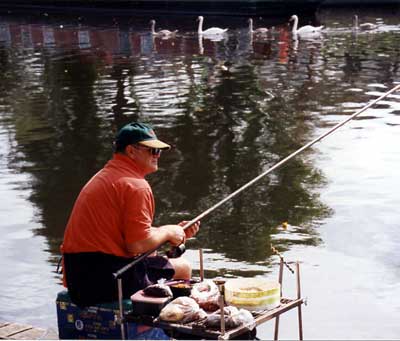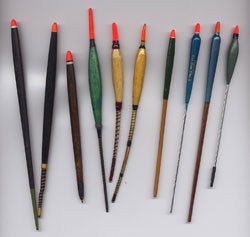Holding back and over-shotting For the moment assume the wind is favourable and consider how the float might be slowed even more, and if so what effect does that have on the bait presentation? Notice how changing the height the rod is held changes the behaviour of the float. In anything other than the most sluggish current retarding the float even more will cause the float to lift out of the water. To counteract this it is possible to fine-tune the shotting so that once again the float is correctly shotted. The range at which an over-shotted float can be successfully used is limited by the conditions, but in general terms it is likely to be at fairly close range. The length of the rod being used, how favourable the wind is, and exactly how much the float is over-shotted have a bearing on the range, together with the degree of skill attained by the angler. The extra shot will also help keep the bait down in the water to counteract the lift from the current. In practice it will also, usually, be necessary to increase the depth. Furthermore the size of float becomes significant. Whilst on the face of it might appear that a heavier float would be easier to hold back this is not always the case and there are times when a well balanced light stick float can be held back to devastating effect. These short paragraphs describe one of the most advanced weapons in the float angler’s armoury for achieving the presentation that will fool big roach on rivers. It must be mastered. Practice, hard. Quietly watch a good angler if you can. Watch how the masters barely disturb the float while the float runs true at the speed they desire. There is no jerking of the float or clumsy strike. Everything is smooth and unhurried. This is your target. I will remind you of a tip. Use a spray line floatant on the spool before tackling up. It is also worthwhile greasing the first three or four feet of line above the float with Mucilin at regular intervals. It is worth taking the opportunity to watch top match anglers at an exhibition match on a river, such as those held at Evesham every August bank holiday (last opportunity this year). Dragging On Can we take the technique further? Certainly. One technique to further slow down the bait is to dramatically increase the length of the tail below the bulk shot. This only works well if the bottom is clean and snag free. It is possible to drag three or four feet of line and some small shot along the bottom with this technique. Sometimes the way to get the best out of a swim means setting up more than one rod for different lines to be fished or to try variations in presentation from time to time. This might mean a stick float and an Avon as an example. Beating the wind Beating the wind is a constant battle that the float angler must try to win. It is not always possible to win but try we must. On the worst days it may be possible to get the presentation right at least part of the time, and if a hotspot in the swim is identified there is a spot that can be concentrated upon. Don’t be afraid of using a heavy float that takes a lot of weight when it comes to beating adverse winds and currents. I have used floats taking up to five swan shot to beat the wind. It might not register the bites so well but you will be getting bites that a lighter float simply will not produce.
The ideal wind is light, upstream and off your back. But sometimes an upstream wind can be too much of a good thing, either stopping the float completely or even dragging the float upstream. This is not usually the desired effect. There are several tactics to counteract this. The simplest one is to increase the size of the float so that the bulk shot helps to pull the float through. Using a different type of float completely can sometimes work, such as a waggler with a sunken line. Using a back shot (a dust shot on the line a few inches above the float) to sink the line with a top and bottom float will work. At other times it is just a matter of working hard at controlling the line so that the line feed is not overly impaired by the wind. Nasty skimming winds One of the trickiest aspects of wind on moving water is when the wind gets the top layer of water skimming along downstream. This is a time for using a much longer rod or pole to get behind the float, using several tiny back shot, switching to waggler tactics or even considering whether float fishing remains appropriate. Learn to beat this one and you truly are a master. I will look at river waggler fishing in a later article. Tricky back currents Another slightly tricky situation is where the speed of current varies across the river. For example, a close big back eddy with a faster run further out where the fish are lying. The drag caused by the slack may need to be overcome to trot through the run successfully. This may mean constantly lifting and relaying the line or perhaps holding the line off the water. Sometimes different parts of the river are travelling in the same direction but at different speeds. Look for opportunities to use the slower current to control the float. Conversely, you may need to hold the line off the water completely to prevent faster water dragging the line. Other tricks for holding a float steady at close range include laying the line on lily pads or rushes to keep the float still, and float-legering. Don’t be afraid to experiment So far these articles have been leading to achieving one aim and that is first class bait presentation. Though location, feeding and tackle are vital in all angling, bait presentation will make or break the enterprise. The starting point has been that for most of the time at least the float is going to be held back to a degree. But this is not a rule set in stone but a guideline. Taking this a step further I have often found, for example, that really big roach want a bait presented completely still, and even more importantly kept that way for a decent length of time, say up to ten or fifteen minutes. Even when the presentation appears, from experience, to be correct there is often the need to experiment further. Moving depth, shot positions, trying different baits in different sizes, different hooks or hooklengths – all of these things can be the difference between success and failure. Some guidance on shotting patterns I do not intend giving hundreds of shotting patterns but instead some guidance based on my own experience. I have sometimes fished a stretch using a particular method and done well, and then watched someone else do equally well with a very different method. And yet both of us achieved the desired effect with our presentation and feeding. To fish top-and-bottom floats there are two basic variations; the bulk shotting, with or without droppers (the tiny ‘tell-tale’ shot nearest to the hook), and the strung out shotting pattern (often known as shirt-button style), which can be tapered with large shot at the top down to the smallest nearest the hook, etc. Each has its merits. The bulk shot method, whereby the shot load is bunched from a foot to three feet from the hook, with or without droppers, is simplicity itself. It casts well and is stable. It is most suited to a swim with an even depth. I like using this with a crowquill Avon but hardly ever a stick. For a balsa I have found that a pattern somewhere between the two works best, and it should be considered more versatile when swims of varying depth are encountered. Part of this is because the floats themselves vary in weight and therefore the way that they behave when cast varies. The ultra-light Avon follows the bulk when cast, and trots better with the shot low down in the water. The balsa is intermediate and can be cast like the Avon with an underarm swing, or like a stick overhead (for distance only). The casting weight in the stick needs strung-out shotting to perform best, and will trot better as well. Drop shots It is necessary at this point to understand the importance of the final (drop) shot. Decades ago debates raged for weeks on whether the drop shot had any effect, with Dick Walker taking on all comers, claiming that a bulk shotting pattern was the only one needed. My experience shows otherwise and I contend that if a fish moves this shot there should be an effect on the float. The nearer it is to the hook and the bigger it is the greater the effect. The nearer and bigger it is, however, the more likely the fish will feel it and drop the bait. It also has a significant effect on bait presentation. The positioning and size of the shot in this position is a compromise between sensitivity, presentation and not alerting the fish. It is rare to position it more than 18 inches from the hook, or closer than six inches. Sometimes an extra tiny shot near the hook can help bait presentation. Experiment! Try different sizes of shot when fishing, move the shot around, and notice the effect. Long trotting This brings us onto the more advanced trotting technique of long trotting. This is generally held to be where the float is trotted more than fifteen yards but could mean distances of more than fifty yards. The advantages include getting a bait to fish that are wary of being approached any closer, and being able to trot to fish where it is not even physically possible to get any closer due to bank-side swamps, bushes or other obstructions. The disadvantages include whether it is possible to accurately feed the swim, to control the float, to successfully strike the bites or even see them. There is a good case for a low stretch line that is well treated with floatant for this type of fishing. Ideal conditions generally preclude strong winds and adverse glare from the sun; conversely too little light may make it impossible to see the float at all. Certainly a long rod is useful to assist in mending the line and hitting the bites. This is a physically demanding type of fishing with the need to constantly lift and mend the line, as well as maintain concentration on the float. Mashed bread feed is well suited to this style of fishing, as it will drift down for a long way giving the fish a taster for the main bait. It is usually more difficult to get maggots or casters to follow the flow for more than about twenty yards so a catapult might be useful in propelling the feed downstream. Next week I shall cover some more advanced techniques, including using a waggler on a river. |
Welcome!Log into your account












